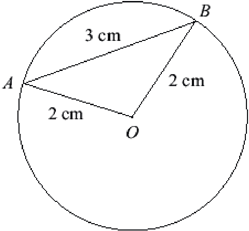| |||
| Math Central | Quandaries & Queries |
|
hi im stuck on this question. i have tried to do some, could you please check it and help me. In this question you should give your answers correct to three decimal (a) The circle below has radius 2 cm, and the chord AB has length 3 cm.
|
Hi,
I don't see where you obtained θ in part 1. I would have used the law of cosines to determine the angle AOB.
In part 2. the area of a sector with central angle θ expressed in radians is 1/2 r2 θ and you know θ from part 1.
I agree with your answer in part 3.
The answer to part 4. is the difference between the area of the sector (part 2.) and the area of the triangle (part 3.).
Penny
 |
||
Math Central is supported by the University of Regina and The Pacific Institute for the Mathematical Sciences.
